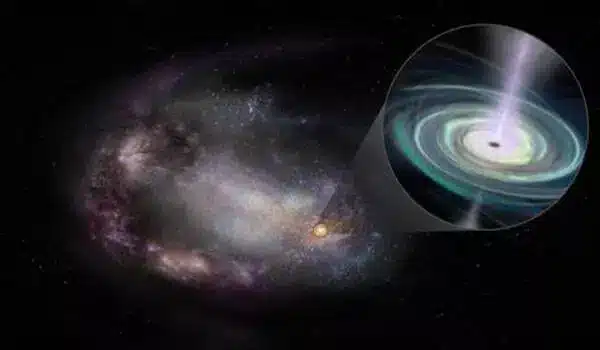Astronomers have discovered that the emissions of black holes, particularly stellar-mass black holes, can vary. This fluctuation can be found throughout the electromagnetic spectrum, from X-rays to radio waves. Understanding this fluctuation can help us understand the physical processes that occur near black holes.
An international team of scientists, including astrophysicists, report on a focused observational campaign on GRS 1915+105, a Galactic microquasar. The scientists discovered previously unseen properties of a microquasar system. Astronomers discovered a quasi-periodic oscillation (QPO) signal in the radio band for the first time from any microquasar system using China’s huge Five-hundred-meter Aperture Spherical radio Telescope (FAST).
Black holes are the most mysterious objects in the universe, with qualities straight out of a science fiction film.
Stellar-mass black holes, for example, with masses of about 10 suns, expose their existence by consuming elements from their companion stars. In other cases, supermassive black holes generate brilliant compact areas known as quasars with masses equal to millions to billions of our sun at the heart of some galaxies. Microquasars are a subclass of accreting stellar-mass black holes that can emit highly magnetized plasma jets.
The peculiar QPO signal has a rough period of 0.2 seconds, or a frequency of about 5 Hertz. Such a signal does not always exist and appears only under certain physical conditions. Our team was fortunate enough to catch the signal twice, in January 2021 and June 2022.
Wei Wang
In the issue of Nature, an international team of scientists, including UNLV astrophysicist Bing Zhang, reports on a focused observational campaign on the Galactic microquasar known as GRS 1915+105. The scientists discovered previously unseen properties of a microquasar system.
Astronomers discovered a quasi-periodic oscillation (QPO) signal in the radio band for the first time from any microquasar system using China’s huge Five-hundred-meter Aperture Spherical radio Telescope (FAST). QPOs are a phenomenon that astronomers utilize to better understand how stellar systems, such as black holes, work. While they have been seen in X-rays from microquasars, their presence as part of the system’s radio emission is unprecedented.

“The peculiar QPO signal has a rough period of 0.2 seconds, or a frequency of about 5 Hertz,” said Wei Wang, a professor at China’s Wuhan University who headed the discovery team. “Such a signal does not always exist and appears only under certain physical conditions.” Our team was fortunate enough to catch the signal twice, in January 2021 and June 2022.”
According to UNLV’s Zhang, director of the Nevada Center for Astrophysics and one of the study’s corresponding authors, this unique feature may provide the first evidence of activity from a “jet” launched by a Galactic stellar-mass black hole. Under certain conditions, some black hole binary systems launch a jet — a mix of parallel beams of charged matter and a magnetic field that moves with a swiftness approaching the speed of light.
“In accreting black hole systems, X-rays usually probe the accretion disk around the black hole, while radio emission typically probes the jet launched from the disk and the black hole,” Zhang explained. “The detailed mechanism to induce temporal modulation in a relativistic jet has not been identified, but one plausible mechanism would be that the jet is underlying precession, which means that the jet direction is regularly pointing towards different directions and returns to the original direction once every about 0.2 seconds.”
Zhang suggested that a misalignment between the black hole’s spin axis and its accretion disk (very hot, brilliant spinning gasses around the black hole) may generate this effect, which is a natural result of spacetime dragging near a rapidly spinning black hole.
“Other possibilities exist, however,” Zhang noted, “and continued observations of this and other Galactic microquasar sources will provide more clues to understanding these mysterious QPO signals.”















